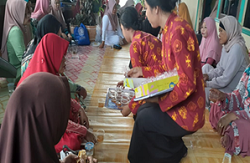Pemberdayaan Para Ibu Rumah Tangga di Kawasan Wisata Flamboyan Kota Palangka Raya Kalimantan Tengah sebagai Upaya Peningkatan Derajat Kesehatan dan Ekonomi Masyarakat Empowerment of Housewives in the Flamboyan Tourism Area of Palangka Raya City, Central Kalimantan as an Effort to Improve the Degree of Health and Economy of the Community
Main Article Content
Abstract
The Flamboyan residential area is one area that has great potential to be developed as a tourist attraction in the city of Palangkaraya so that it has business opportunities for the local community, especially housewives to increase family income. But the area also has health problems that must be immediately addressed to become a comfortable tourist area to visit. Community service activities carried out have the aim of improving the degree of health and economic status of the community in the Flamboyan tourist area through improving the skills and knowledge of housewives. The stages of this activity are counseling or socialization of prevention and treatment of infectious diseases as well as the socialization of clean and healthy living behavior, the practice of making Bawang Dayak Gummy, and the practice of processing haruan fish oil. Community service activities that have been carried out have received good appreciation from partners, this can be seen from the results of the evaluation conducted knowledge and skills that have been given can be practiced by partners directly and partners have felt the positive impact of the results of community service activities such as being able to do independent treatment for minor ailments that often affects family members.
Downloads
Article Details
Authors who publish with this journal agree to the following terms:
- Any article on the copyright is retained by the author(s).
- Author grant the journal, right of first publication with the work simultaneously licensed under a Creative Commons Attribution License that allows others to share work with acknowledgment of the work authors and initial publications in this journal.
- Authors are able to enter into a separate, additional contractual arrangements for non-exclusive distribution of published articles of work (eg, post-institutional repository) or publish it in a book, with acknowledgment of its initial publication in this journal.
- Authors are permitted and encouraged to post their work online (e.g., in institutional repositories or on their websites) prior to and during the submission process, as can lead to productive exchanges, as well as earlier and greater citation of published work.
- The article and any associated published material is distributed under the Creative Commons Attribution-ShareAlike 4.0 International License
References
Kenedyanti, E., Sulistyorini, L. 2017. Analysis Of Mycobacterium Tuberculosis And Physical Condition Of The House With Incidence Pulmonary Tuberculosis. Jurnal Berkala Epidemiologi. 5(2):152-162. http://dx.doi.org/10.20473/jbe.V5I22017.152-162
Mahbub, A.S., Wahyunira, A., Achmad, A. 2018. Persepsi Masyarakat Terhadap Rencana Pembangunan Ekowisata Karst Di Desa Sambueja, Kecamatan Simbang, Kabupaten Maros. Perennial. 14(2):51-60. http://dx.doi.org/10.24259/perennial.v14i2.5648
Primadany, S.R., Mardiyono, Riyanto. 2013. Analisis Strategi Pengembangan Pariwisata Daerah (Studi Pada Dinas Kebudayaan Dan Pariwisata Daerah Kabupaten Nganjuk). JAP (Jurnal Administrasi Publik). 1(4):135-143.
Rahman. 2006. Perencanaan dan Pengembangan Pariwisata. Jakarta: Pradnya Paramita.
Sueca, N.P. 2004. Permukiman Kumuh, Masalah Atau Solusi? Natah. 2(2):56-107.
Suradi. 2016. Model Identifikasi Permasalahan Sosial Di Kawasan Kumuh Perkotaan. Sosio Informa. 1(2):106-120. https://doi.org/10.33007/inf.v1i2.141
Susanti, I., Handoyo, P. 2015. Perilaku Menyimpang Dikalangan Remaja Pada Masyarakat Karangmojo Plandaan Jombang. Paradigma. 3(2):1-6.
Sutrisno, H. 2012. Konsep Penataan Kembali Ruang Terbuka Hijau Pada Kawasan Flamboyan Bawah Kota Palangka Raya. Jurnal Perspektif Arsitektur. 7(2):1-8.
Yani, A. 2008. Sertifikasi Kawasan Wisata Untuk Perlindungan Budaya Dan Pelestarian Lingkungan Hidup (Kebutuhan Mendesak dalam Menyongsong Tahun Kunjungan Wisata Nusantara). Jurnal Geografi Gea. 8(1):82-93. https://doi.org/10.17509/gea.v8i1.1694
